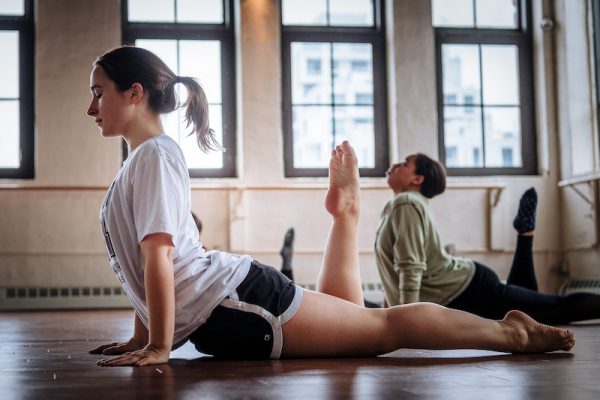May 22-23, online performance presented by Mile Zero Dance in Edmonton
I’ll confess: digital access is great and expedient, but it makes me hungry to experience dance works and artistic expression in person. I know accessibility is on people’s minds, artists and viewers alike, and we are all too aware of the loss of the theatrical agora we’ve arguably taken for granted in the first place. The performative piece Silvering, by Thea Patterson, created in collaboration with the scenographer and visual artist Jeremy Gordaneer, was set to be shown pre-COVID-19, before a live audience at Edmonton’s Mile Zero Dance. But then everything shifted, and they were pushed to reconceive the work.
The now broader choreographic project, retitled Silvering in Confinement, imagines new ways of being together. The pivot from the original conception means the piece is now about how to interact and engage with screens, how to be with other performers in four different locations, how to meet through cyber technology and how to keep it all in balance. As Patterson notes, they sought to acknowledge and interrogate technology, “the camera, the screen and the flatness as part of the space we are in, as well as re-imagining how to welcome those not physically present into our world.”

Silvering in Confinement presents the tensions and resolutions of extricating liveness from a multitude of stages and screens, each in a landscape of found silver tubular and spiral objects, and sheets constructed of padded insulation. The dancers, Elinor Fueter (Montréal), Nancy Sandercock (Los Angeles), Jeanie Vandekerkhove (Edmonton) and Patterson (Edmonton), interact with the objects, brought to virtual life in each city by videographers Eleonora Barna, Brittany Ball-Snellen and Sigrid Patterson. Thea Patterson’s research and discourse engages with what the political theorist Jane Bennett refers to as “thing-power, the curious ability of inanimate things to animate, to act, to produce effects dramatic and subtle.” By extension, she’s examining the aesthetic function of performing human bodies onstage. In their collective engagement, Patterson and Gordaneer are endeavouring to visit/revisit the heterogeneity-homogeneity of an artwork reconstituted within a dialogue of different mediums.

Silver-coated glimmering wires, flat metals, sheets and other objects litter the floor and hang suspended, and the performers interact with the objects with calm assurance. The dancers go about their business, sometimes with bounding, springy steps, even within a restricted space, or with a quiet preoccupied air. Arms extend wide and upwards; other times dancers enter and exit the frame without fanfare. Patterson makes us see the dancing as an expression of fragmentation, dislocation and disassociation. The soundtrack, by respectfulchild, of children playing outdoors with the ambient wind captured during an outdoor sequence, is handled with casual gentleness. Dimensionality is curious in the computer frame, with objects either massive, just tiny or distorted. Further, it was sometimes difficult to perceive the intimacy that the bodies had with these pieces or sense the tactility of the material.

Hats off to the creators’ daunting achievement to embed the intention of live performance in the online digital space. I certainly wasn’t disturbed by the instability of the platform, the lags, the glitches, the freezes and the occasional fragmented pixilated images. I was even understanding about the fact that everyone watching was muted. I’m reminded of a line I heard recently that stuck: “Digital is the new melancholy.” In-person access may become a luxury in the future. In light of the current crisis, it’s important to understand what kinds of stories we want to tell, especially in a time when we’re so desperately disconnected.
Tagged: Contemporary, All






